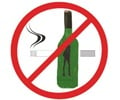Adolescent girls born into a family history of breast disease, cancer or the benign lesions (could become cancer), face higher risk of developing benign breast disease as young women than other girls.

This study is one of the first to look at alcohol consumption in adolescents and the risk of breast disease. Most studies linking alcohol to the risk of developing breast cancer focus on women in their 40s, 50s and 60s and on their risk of invasive breast cancer, not the risk of early, benign lesions that may lead to invasive breast cancer.
One such study published Nov. 2 in the Journal of the American Medical Association, in which Colditz was a co-author, found a moderate increase in breast cancer risk with as few as three to six drinks per week for any adult women, regardless of family history.
"In the current study, we have tried to disentangle the effects of alcohol in women with a family history that includes both breast cancer and benign breast disease, compared to women with no family history," Colditz says. "And we're seeing the strongest effect of alcohol in women with breast disease in the family."
The new study of younger women began in 1996 with more than 9,000 girls from all 50 states who are daughters of participants in the Nurses' Health Study II. The girls were ages nine to 15 when they completed baseline questionnaires. Follow-up questionnaires over the next five years and surveys in 2003, 2005 and 2007 tracked family history, alcoholic beverage intake, height, weight, waist circumference and age of first menstrual period, among other factors that influence breast cancer risk.
The 2005 and 2007 surveys, conducted when the participants were ages 18 to 27, asked whether they had ever been diagnosed with benign breast disease, a large class of conditions that can cause breast lumps or pain and are a known risk factor for breast cancer. Sixty-seven of the young women reported a diagnosis of benign breast disease that was confirmed by biopsy, and 6,741 reported no such diagnosis.
Advertisement
And alcohol heightened a young girl's risk further if she had a family history. Girls whose mothers, aunts or grandmothers had breast cancer were more likely to develop benign breast disease, and their risk increased with the amount of alcohol they consumed. The same was true of the daughters of women with benign breast disease.
Advertisement
"Increasing height is related to breast cancer risk," Colditz says. "And some data point to faster growth spurts leading to a higher risk of subsequent cancer. Obviously, that's not something we can control. But if we can understand what is going on in terms of hormones and processes in the body and the role of physical activity and diet, we may be able to modify some of that accumulation of breast cancer risk through the early years."
Source-Eurekalert















